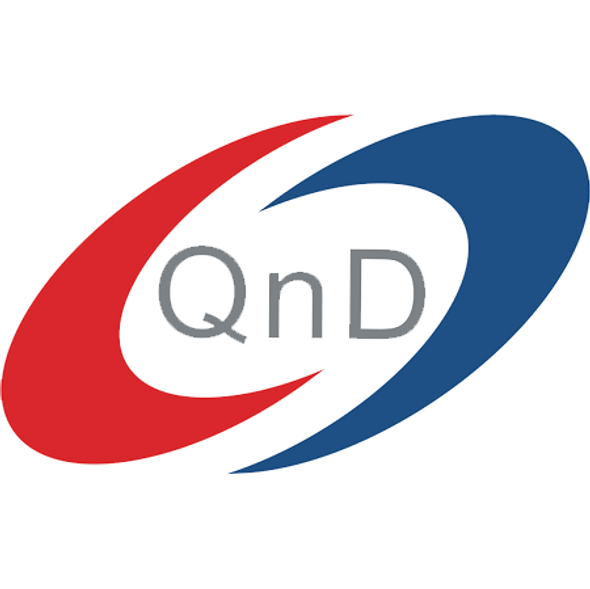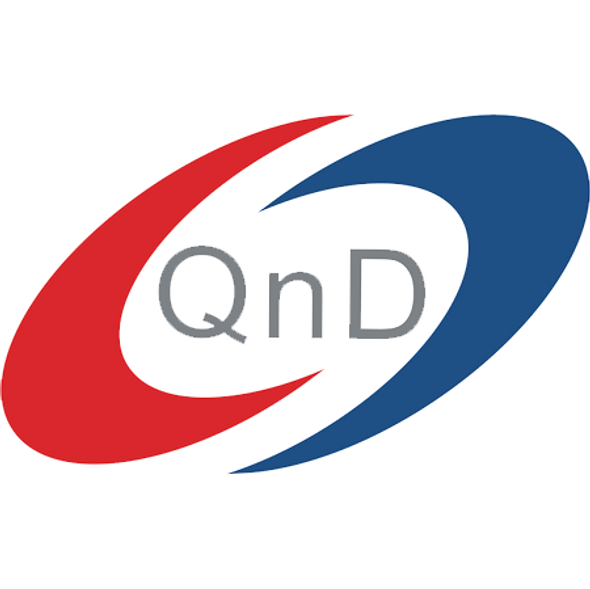Jaica
New 8-OHdG Check ELISA
- SKU:
- KOG-200SE
- Availability:
- We ship within 8 hours of receiving your order. Next day delivery of all Jaica New 8-OHdG Check ELISA Kit except for weekends.
- Weight:
- 1 KGS
- Shipping:
- Calculated at Checkout
Description
8-hydroxy-2' -deoxyguanosine detection Kit
Jaica New 8-OHdG Check ELISA Kit



| Keywords: | Biomarker DNA oxidation, Molecular Aging, DNA Damage 8-Hydroxy-2-deoxy Guanosine |
| Supplier: | JaICA |
| Supplier-Nr: | KOG-200SE |
NNS-KOG-200SE-EX
“New 8-OHdG Check”
INSTRUCTIONS
- The 8-OHdG Check is a competitive in vitro enzyme-linked immunosorbent assay (ELISA) for quantitative
detection of the oxidative DNA adduct 8-hydroxy-2’-deoxyguanosine (8-OHdG) . - Suitable for urine, serum, plasma, tissue and other biological samples. For research use only. Not for diagnostic nor medical use.
- Read entire insert before use.
- 8 oxodgoxidative stressoxidative dna damageurinecalibrationkitgentaurcosmo bioassay kitelisa kitsng mlelisa assaydeoxyguanosineelisa detectionbiomarkerimmunosorbent assay
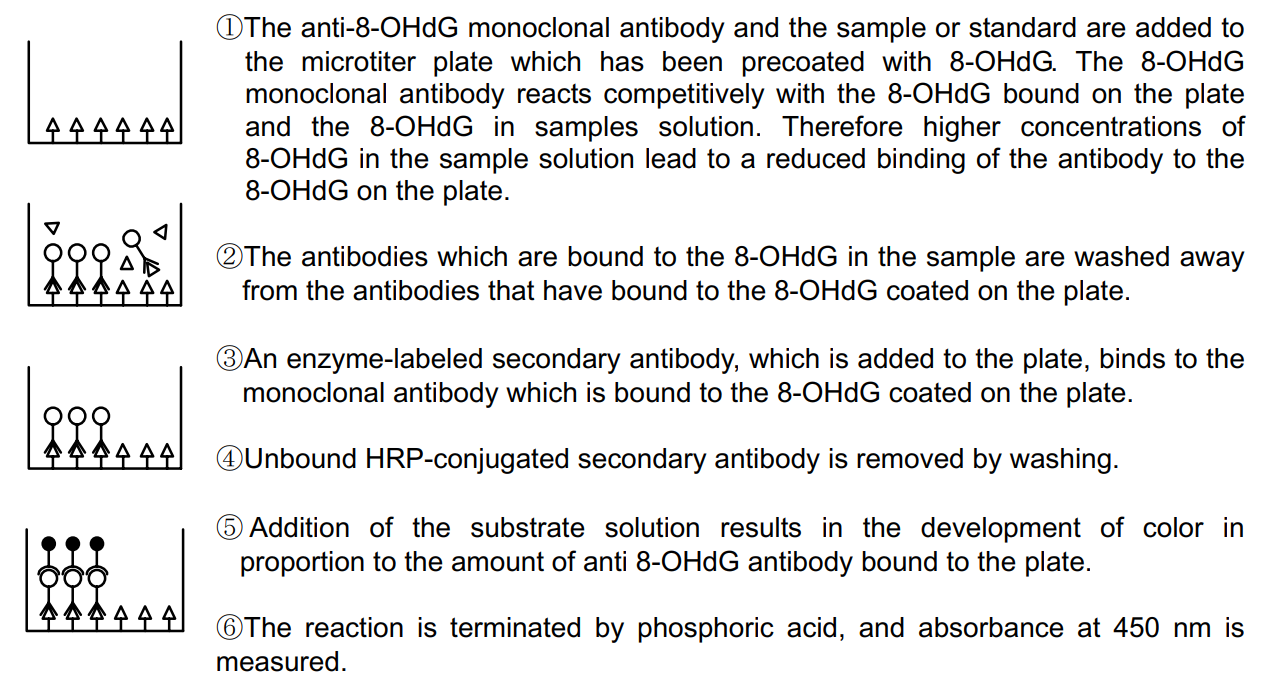
1. Kit Contents
ձ8-OHdG Microtiter Plate 㸸Precoated with 8-OHdG(84wells, split type) 1 plate
ղPrimary Antibody 㸸Anti 8-OHdG Monoclonal antibody (clone N45.1) 1 vial
ճPrimary Antibody Solution 㸸Phosphate buffered saline 1 vial
մSecondary Antibody 㸸HRP-conjugated anti mouse antibody 1 vial
յSecondary Antibody Solution 㸸Phosphate buffered saline 1 vial
նChromatic Solution 㸸3,3',5,5'-tetramethylbenzidine 1 vial
շDiluting Solution 㸸Hydrogen peroxide/citrate-phosphate buffered saline 1 vial
ոWashing Solution(5x) 㸸5 times concentrated phosphate buffered saline 2 vials
չReaction Terminating Solution 㸸1M Phosphoric acid 1 vial
պStandard 8-OHdG Solution 㸸Purified 8-OHdG (0.5, 2, 8, 20, 80, 200 ng/mL) 1 vial each
ջPlate Seal 2 sheets
All reagent should be stored at 2-8°C. The expiry date is 12 months after manufacture.
After the seal of above contents are opened, this kit should be used within 2 weeks.
2. Additional Materials and Equipments Required
ձDistilled water.
ղ50µL micropipettor and pipette tips
ճ8-channel micropipettor (50㹼200µL) and pipette tips
մReagent trays for 8-channel micropipettor
յA 37°C incubator
նMicrotiter plate reader (measuring wavelength = 450 nm)
3. Priciples of the Procedure
ձThe anti-8-OHdG monoclonal antibody and the sample or standard are added to
the microtiter plate which has been precoated with 8-OHdG. The 8-OHdG
monoclonal antibody reacts competitively with the 8-OHdG bound on the plate
and the 8-OHdG in samples solution. Therefore higher concentrations of
8-OHdG in the sample solution lead to a reduced binding of the antibody to the
8-OHdG on the plate.
ղThe antibodies which are bound to the 8-OHdG in the sample are washed away
from the antibodies that have bound to the 8-OHdG coated on the plate.
ճAn enzyme-labeled secondary antibody, which is added to the plate, binds to the
monoclonal antibody which is bound to the 8-OHdG coated on the plate.
մUnbound HRP-conjugated secondary antibody is removed by washing.
յ Addition of the substrate solution results in the development of color in
proportion to the amount of anti 8-OHdG antibody bound to the plate.
նThe reaction is terminated by phosphoric acid, and absorbance at 450 nm is
measured.
4. Assay Procedure
Bring all reagents and samples to room temperature (20-25ºC) before use.
A) Reconstitute the ղPrimary Antibody with the ճPrimary Antibody Solution.
B) Add 50µL of sample or պStandard per well, as shown in plate diagram.
C) Add 50µL of reconstituted primary antibody per well. Shake the plate from side to side and mix fully.
Cover plate with adhesive strip, making sure it is sealed tightly. Incubate at 37°C for 1 hour.
D) Mix 1 volume of ոWashing solution(5x) with 4 volumes of distilled water.
E) Pour off contents of wells into sink. Pipette 250µL washing solution into each well. After washing
thoroughly by shaking the plate from side to side, dispose of washing solution. Invert plate and blot
against clean paper towel to remove any remaining washing buffer. Repeat wash two times more.
The use of washing machines or aspirators is not recommended.
F) Reconstitute the մSecondary Antibody with the յSecondary Antibody Solution.
G) Add 100µL of constituted secondary antibody per well. Shake the plate from side to side and mix fully.
Cover the plate with an adhesive strip. Incubate 37°C for 1 hour.
H) At the end of the incubation period, repeat washing as in step E.
I) Prepare substrate solution. Add 1 volume of նChromatic Solution to 100 volumes of շDiluting Solution
just before use. Add 100µL of substrate solution per well. Shake the plate from side to side and mix fully.
Incubate at room temperature for 15 minutes in the dark.
J) Add 100µL of the չReaction Terminating Solution. Shake the plate from side to side and mix fully.
K) Measure the absorbance at 450 nm using mictotiter plate reader.
Use a standard curve to determine the amount of 8-OHdG present in test samples. Generate the
standard curve by plotting absorbance vs. log (concentration of standards). Then use the absorbance
values obtained for the test samples to determine the concentrations.
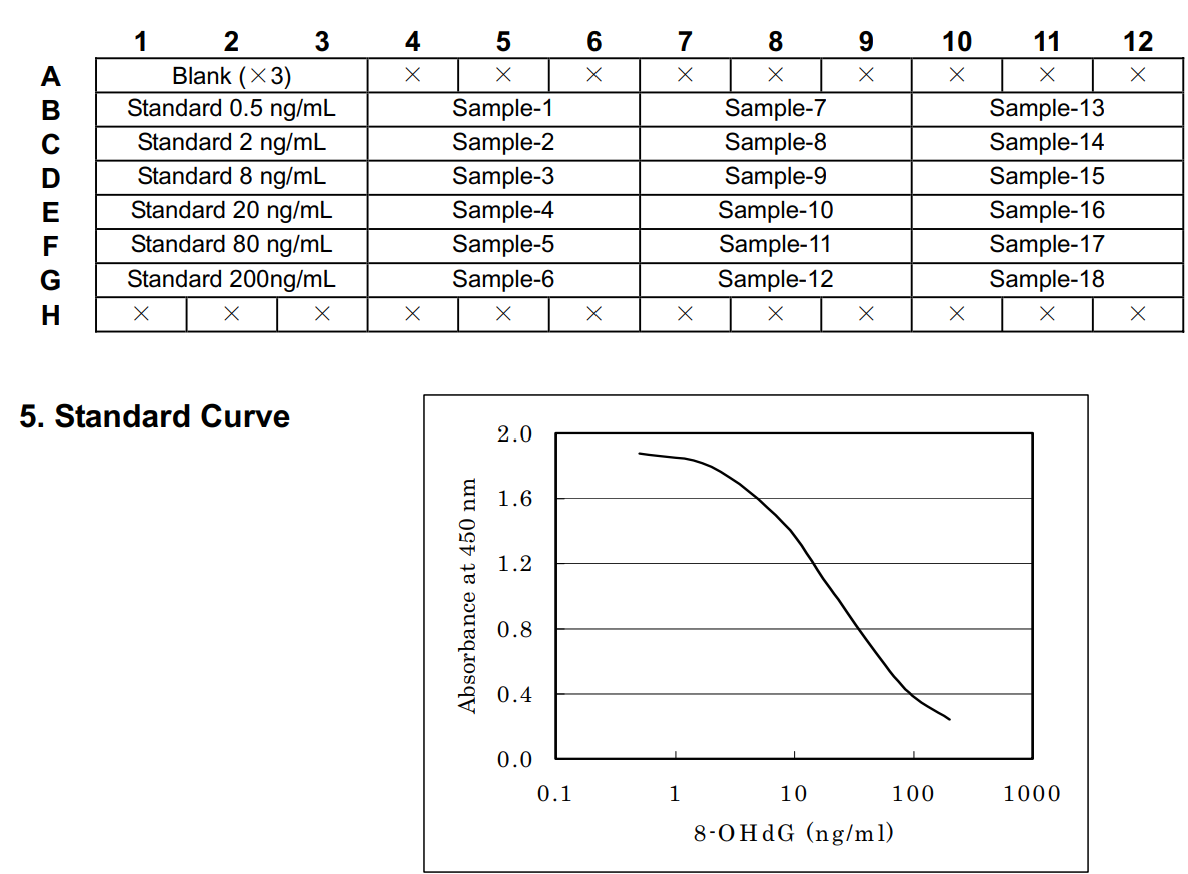
Notices
1) Sample Pretreatment
To assay properly, please pre-treat samples as follows. Avoid repeated freeze and thaw.
ձ Urine : If it's clear, pretreatment is not needed.
Centrifugation at 2,000 ~ 5,000g for 10 ~ 15 minutes is recommended for opaque samples only.
ղ Serum : Blood samples must be separated to serum immediately. To separate interfering substances,
filtration of serum using an ultra filter (cut off molecular weight 10,000) is necessary. Pre-treat ultra
filter following to the maker’s manuals. In order to reduce deviation, diluting samples by more than
twice, while paying attention to concentration range is suggested.
ճ DNA in Tissue : It’s necessary to extract and digest DNA in the samples beforehand.
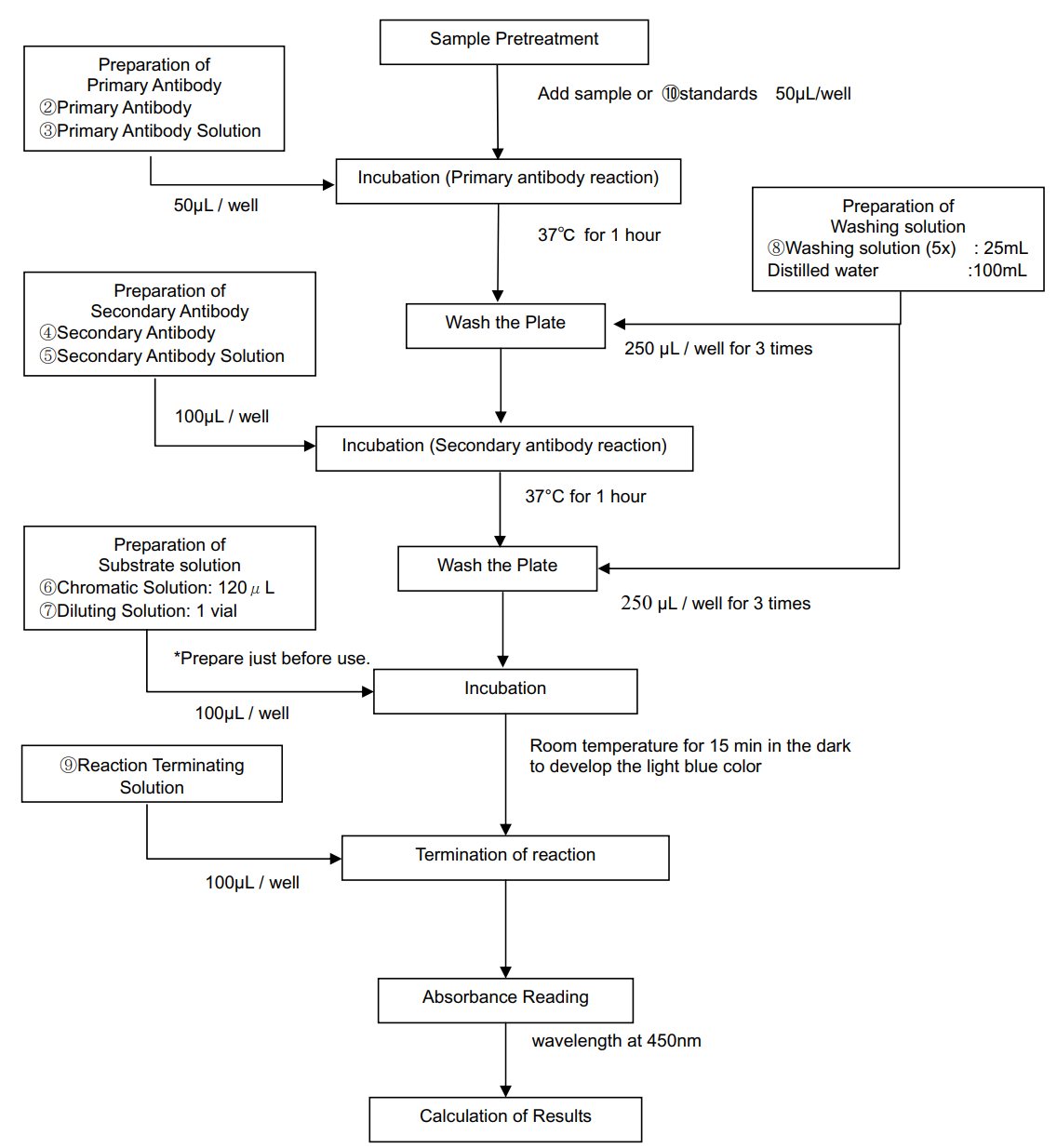
2) Measurement
ձStrict Control of Incubation Temperature
Measured values may be very much affected with the incubation temperatures, particularly during
primary antibody reaction period. Please pay attention to followings;
a. Try to keep uniform temperature inside a plate constantly.
b. It's recommendable to use water bath rather than dry incubators for the incubation.
ղ Adjustment of pH for samples
It is necessary to maintain pH of a sample mixed with primary solution between 6.0 to 8.0. It's
recommendable for abnormal urine samples to be diluted with PBS by three times.
ճ Thoroughly Washing of Micro plates
It's recommendable to throw the micro plate down on clean paper towel to remove solution in side
wells, after a plate is turn over and solution in side wells is discarded.
մ Cleaning of Instruments and Vessels
8-hydroxy-2'-deoxyguanosine (8-OHdG / 8-oxo-dG) ELISA kit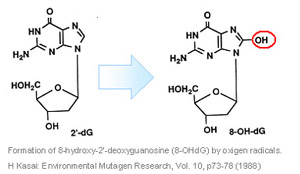
"8-OHdG Check" is a competitive enzyme-linked immunosorbent assay for quantitative measurement of the oxidative DNA adduct 8-hydroxy-2'-deoxyguanosine (8-OHdG) in DNA of tissue, urine, serum.
The characteristic features of this kit are:
| 1. | Easy operation: | No requirement of expensive equipments and sample pretreatment. |
| 2. | High sensitivity: | Monoclonal antibodies recognize 8-OHdG specifically (21 analogues of 8-OHdG do not have any cross reactivity). |
| 3. | Fast: | Estimated time of assay is 3.5 to 4 hours. |
| 4. | Sample capacity of one kit with a blank and standard is 18 for triplicate samples. Only 150l of sample is required (50l per well). | |
| 5. | Split type microplates prevents excessive use of test samples. | |
What are the advantages of the "8-OHdG Check" Kit?
The "8-OHdG Check"is useful as a non-invasive indicator in various fields as follows. In a primary evaluation of individual life style; in general, to learn whether individual antioxidant system are controlling excess active oxygen generated inside body properly and whether the oxidative stress is restrained within manageable limits, so that whether individual life style is in a state to prevent from diseases and to aging to enjoy the individual maximum life span.
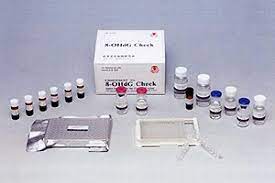
| 2 | In assessing the effect of antioxidant substance (food) in vivo. |
| 3 | In evaluating how much oxidative stress is generated by exercises performed or specific activities to which body is subjected to. |
| 4 | In studying the correlation between disease and oxidative stress. |
| 5 | In determining the side effect of oxidative stress following a specific clinical treatment procedure or pharmaceutical dose of medicine. |
| * | Such techniques as HPLC-EC and LC-MS/MS which, by the nature of their procedure, measure only free form of 8-OHdG in biological samples, and can not detect 8-OHdG contained with in oligomers or 8-OHdG derivatives such as 8-OHdG holding SO3- or Glucuronic acid. ELISA technique is preferable to detect over all oxidative stress level in side body. (Referred by M.S.Cooke etc. Free Radical Research. 36(9), pp929-932 (2002) |
| 1. | Microtiter plate coated with 8-OHdG (split type) |
| 2. | Primary antibody (Anti-8-OHdG monoclonal antibody) |
| 3. | Primary antibody solution |
| 4. | Secondary antibody (POD-conjugated anti mouse antibody) |
| 5. | Secondary antibody solution |
| 6. | Chromatic solution (3,3',5,5'-tetramethylbenzidine) |
| 7. | Substrate solution |
| 8. | Washing solution |
| 9. | Reaction terminating solution |
| 10. | Standard 8-OHdG solution (0.5, 2, 8, 20, 80, 200 ng/ml) |
| 11. | Plate seal |
| 1. | Primary Antibody Reaction (Competitive Reaction): 37°C for 1 hour |
| 2. | Secondary Antibody Reaction: 37°C for 1 hour |
| 3. | Development of Color Reaction: Room Temperature for 15 min in the dark |
| 4. | Absorbance Reading (wavelength at 450 nm) and Calculation of Results |
Instruments and vessels (such as tips, trays for 8 channel pipettor) to be used, must be clean. If such
tools are used repeatedly, please boil or steep them into alkaline cleanser, then wash thoroughly and
dry them before use.
3) Split Usage
ձRemained parts of kit (plate and reagents) must be kept in a refrigerator and must be used within two
weeks after opened.
ղPlates and reagents except chromatic solution are taken out from refrigerator and are kept in room
temperature beforehand. Necessary volume of Chromatic solution may be added to adequate volume
only of Diluting solution just before the reaction. Keep it in the dark.
www.cosmobio.co.jp
Application Set Quantitative ELISA
Specificity Specific for 8-OHdG. Has been tested to 8-OHdG analogues (guanosine(G),7-methyl-G, 6-SH-G, 8-Bromo-G, dA, dC, dT, dI, dU, dG, O6-methyl-dG,8-OHdA, guanine(Gua),O6-methyl-Gua, 8-OH-Gua, uric acid, urea, creatine, creatinine, 8-sulfhydryl-G, 8-OH-G).
Crossreactivity All
Quantity 96 wells
Range 0.5 to 200 ng/mL
Sample Type Urine
Assay Type Competitive
Detection Type Colorimetric
Other Product Data This ELISA Kit is suitable for urine and serum samples from animal and human. However, for human serum, tissue and cultured cells, we recommend 8-OHdG Check ELISA Kit (High Sensitivity) (JAI-KOG-HS10E).
Detection Guide for Serum/Plasma
Detection Guide for Urine
Declaration Manufactured by JaICA.
Shipping and Handling
Shipping BLUE ICE
Short Term Storage +4°C
Long Term Storage +4°C
Handling Advice Do not freeze.
Use/Stability 12 months after the day of manufacturing. See expiry date on ELISA Kit box.
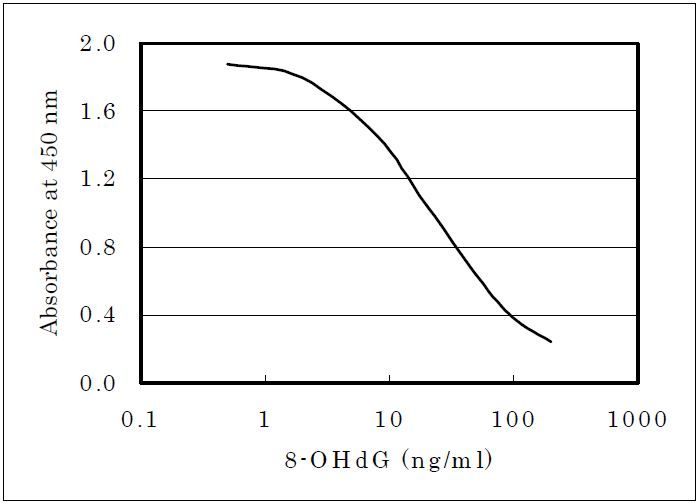
8-hydroxy-2'-deoxyguanosine (8-OHdG) is a modified base that occurs in DNA due to attack by hydroxyl radicals (incl. singlet oxygen and direct photodynamic action) that are formed as byproducts and intermediates of aerobic metabolism and during oxidative stress. There is increasing evidence to support the involvement of free radical reactions in the damage of biomolecules that eventually lead to several diseases in humans, such as atherosclerosis, cerebral and heart ischemia-reperfusion injury, cancer, rheumatoid arthritis, inflammation, diabetes, aging, and neurodegenerative conditions, such as Alzheimer’s disease. 8-OHdG is popular as a sensitive, stable and integral marker of oxidative damage in cellular DNA and can be detected in tissue, serum, urine and other biomaterials.
- Quantitative determination of urinary 8-hydroxydeoxyguanosine (8-OH-dg) by using ELISA: S. Saito, et al.; Res. Commun. Mol. Pathol. Pharmacol. 107, 39 (2000) [Development and assessment of 8-OHdG Check ELISA]
- Urinary 8-hydroxy-2'-deoxyguanosine levels increase after reperfusion in acute myocardial infarction and may predict subsequent cardiac events: Y. Nagayoshi, et al.; Am. J. Cardiol. 95, 514 (2005) [Measurement of 8-OHdG in human urine]
- The effects of an antioxidant-supplemented beverage on exercise-induced oxidative stress: results from a placebo-controlled double-blind study in cyclists: J. Morillas-Ruiz, et al.; Eur. J. Appl. Physiol. 95, 543 (2005) [Study about exercise, antioxidant supplements and urinary 8-OHdG]
- Effect of a novel free radical scavenger, edaravone, on puromycin aminonucleoside induced nephrosis in rats: T. Someya, et al.; Pediatr. Nephrol. 20, 1430 (2005) [Effect of antioxidants to 8-OHdG in rat urine]
- Acute encephalopathy with refractory status epilepticus: Bilateral mesial temporal and claustral lesions, associated with a peripheral marker of oxidative DNA damage: T. Shiihara, et al.; J. Neurol. Sci. 250, 159 (2006) [Measurement of 8-OHdG in human urine, serum and cerebro spinal fluid(CSF)]
Videos
-

Gentaur - Laboratory research products
Antibodies, Antigens, ELISA kits, PCR kits and others - World...
-

8-OHdG, One of the Most Well Researched Markers of Oxidative Stress; indicating risk for Cancer
8-OHdG, One of the Most Well Researched Markers of Oxidative S...
-

Enzyme-Linked Immunosorbent Assay (ELISA) - Multi-Lingual Captions
This short animation demonstrates enzyme-linked immunosorbent ...
-

DNA Oxidation | DNA Damage by ROS
DNA oxidation is the process of oxidative damage on Deoxyribon...
-

Mutagens and carcinogens | Biomolecules | MCAT | Khan Academy
Created by Ross Firestone. Watch the next lesson: https://www...
-

Overview of DNA Damage
NA damage is an alteration in the chemical structure of DNA, s...
-

165-DNA Damage
Review of the types and frequencies of damage to DNA
Warranty Information
1 Review
-
Sensitivity
This is the most sensitive 8 Ohdg Elisa kit for urine oxidative stress measurements.


















